shiro权限绕过漏洞,本文将这三个权限绕过的洞进行对比,他们的编号分别是 CVE-2020-1957、CVE-2020-11989、CVE-2020-13933
0x01 简述
前段时间太忙了,忙到很多东西,只是记录了笔记,没有成文,刚好最近阶段又出来了shiro权限绕过漏洞,因此本文将这三个权限绕过的洞进行对比,他们的编号分别是 CVE-2020-1957、CVE-2020-11989、CVE-2020-13933 。
0x02 漏洞细节
1、CVE-2020-1957
原理

首先在 admin 位置下断点,可以看到,我们网络请求,是先经过 shiro 处理之后,再转发到 springboot 进行路由分发工作。
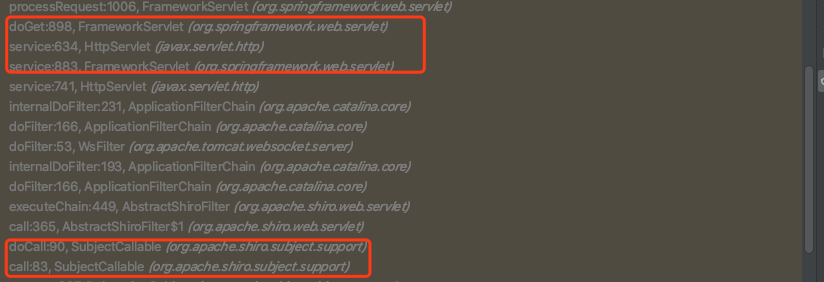
这里直接定位到 shiro 处理 url 的方法位置:WebUtils#getPathWithinApplication
public static String getPathWithinApplication(HttpServletRequest request) {
String contextPath = getContextPath(request);
String requestUri = getRequestUri(request);
if (StringUtils.startsWithIgnoreCase(requestUri, contextPath)) {
// Normal case: URI contains context path.
String path = requestUri.substring(contextPath.length());
return (StringUtils.hasText(path) ? path : "/");
} else {
// Special case: rather unusual.
return requestUri;
}
}
实际上继续跟进 getRequestUri(request); 这个方法,可以清楚的看到,实际上调用的是 getRequestURI 方法来获取路由中的 URI 请求。
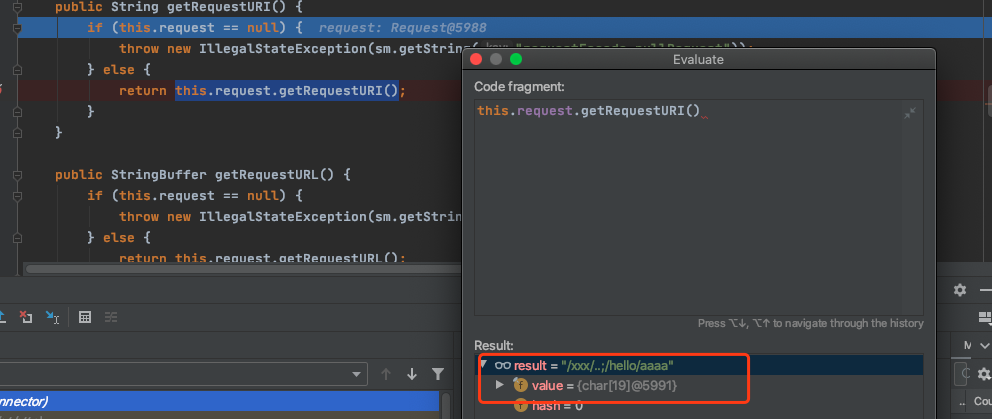
这里的 URI 就是我们传入的/xxx/..;/hello/aaaa,也就是说回到 getRequestUri(request); 当中,会带着这个传入的 URI 进入 decodeAndCleanUriString 进行处理。
public static String getRequestUri(HttpServletRequest request) {
String uri = (String) request.getAttribute(INCLUDE_REQUEST_URI_ATTRIBUTE);
if (uri == null) {
uri = request.getRequestURI();
}
return normalize(decodeAndCleanUriString(request, uri));
}
在 decodeAndCleanUriString 方法中会根据我们的传入的URI中;进行截断处理,也就是说经过处理之后,返回的结果变成了/xxx/..
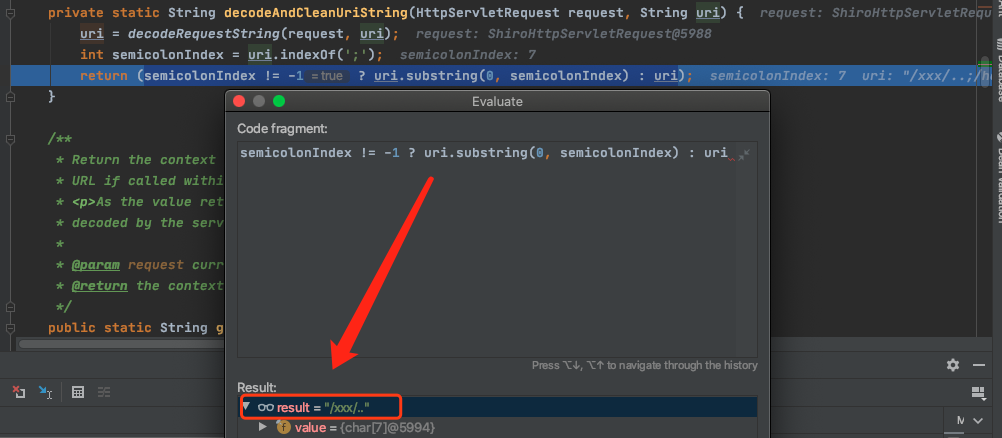
而 normalize 方法就会对我们传入的path进行一些处理,从注释上,也能知道这部分代码处理了什么东西:
- 替换
\\为/ - 替换
/./为/ - 替换
/../为/ - ...
private static String normalize(String path, boolean replaceBackSlash) {
if (path == null)
return null;
// Create a place for the normalized path
String normalized = path;
if (replaceBackSlash && normalized.indexOf('\\') >= 0)
normalized = normalized.replace('\\', '/');
if (normalized.equals("/."))
return "/";
// Add a leading "/" if necessary
if (!normalized.startsWith("/"))
normalized = "/" + normalized;
// Resolve occurrences of "//" in the normalized path
while (true) {
int index = normalized.indexOf("//");
if (index < 0)
break;
normalized = normalized.substring(0, index) +
normalized.substring(index + 1);
}
// Resolve occurrences of "/./" in the normalized path
while (true) {
int index = normalized.indexOf("/./");
if (index < 0)
break;
normalized = normalized.substring(0, index) +
normalized.substring(index + 2);
}
// Resolve occurrences of "/../" in the normalized path
while (true) {
int index = normalized.indexOf("/../");
if (index < 0)
break;
if (index == 0)
return (null); // Trying to go outside our context
int index2 = normalized.lastIndexOf('/', index - 1);
normalized = normalized.substring(0, index2) +
normalized.substring(index + 3);
}
// Return the normalized path that we have completed
return (normalized);
}
而这里经过处理,我们的 URI 依然是/xxx/..,接着就会回到 PathMatchingFilterChainResolver#getChain 方法,进行权限匹配,我们的路径是/hello/**下需要进行权限认证,由于路径不匹配,所以权限校验自然过了。

这里在提一嘴,可以看看 PathMatchingFilterChainResolver#getChain 方法这一小段代码,这一段代码修复的是 Shiro-682 ,具体描述可以点入链接查看。简单翻译一下就是在 spring web 下,通过请求 /resource/menus 和 /resource/menus/ 都是能够访问到资源的,但是shiro的路径正则只会匹配到 /resource/menus ,忽略了 /resource/menus/ ,所以这就绕过了。


好了,这里提一下这个地方,再回到我们刚刚上面的情况里,由于我们传入的 URI /xxx/..与权限认证的 URI /hello/**不匹配,绕过了权限验证之后,进入 springboot 当中进行路由分发,而在 spring 当中 UrlPathHelper#getPathWithinServletMapping 这个方法负责处理我们传入的 URI :xxx/..;/hello/aaaa,结果是返回 servletPath 。
public String getPathWithinServletMapping(HttpServletRequest request) {
String pathWithinApp = getPathWithinApplication(request);
String servletPath = getServletPath(request);
String sanitizedPathWithinApp = getSanitizedPath(pathWithinApp);
String path;
// If the app container sanitized the servletPath, check against the sanitized version
if (servletPath.contains(sanitizedPathWithinApp)) {
path = getRemainingPath(sanitizedPathWithinApp, servletPath, false);
}
else {
path = getRemainingPath(pathWithinApp, servletPath, false);
}
...
// Otherwise, use the full servlet path.
return servletPath;
}
}
看看 servletPath 是怎么来的,这玩意的取值是通过request.getServletPath();获取到的,也就是说这里的结果是/hello/aaaa。这里通过 springboot 进行分发,自然获取到后台接口内容,整个流程:
用户发起请求/xxx/..;/hello/aaaa----->shiro处理之后返回/xxx/..通过校验的----->springboot处理/xxx/..;/hello/aaaa返回/hello/aaaa,最后访问到需要权限校验的资源。
public String getServletPath(HttpServletRequest request) {
String servletPath = (String) request.getAttribute(WebUtils.INCLUDE_SERVLET_PATH_ATTRIBUTE);
if (servletPath == null) {
servletPath = request.getServletPath();
}
if (servletPath.length() > 1 && servletPath.endsWith("/") && shouldRemoveTrailingServletPathSlash(request)) {
// On WebSphere, in non-compliant mode, for a "/foo/" case that would be "/foo"
// on all other servlet containers: removing trailing slash, proceeding with
// that remaining slash as final lookup path...
servletPath = servletPath.substring(0, servletPath.length() - 1);
}
return servletPath;
}

修复
shiro在1.5.2当中把之前的通过 getRequestURI 获取URI的方式变成了 getContextPath() 、getServletPath() 、getPathInfo() 的组合。

这么处理之后自然变成了想要的东西。
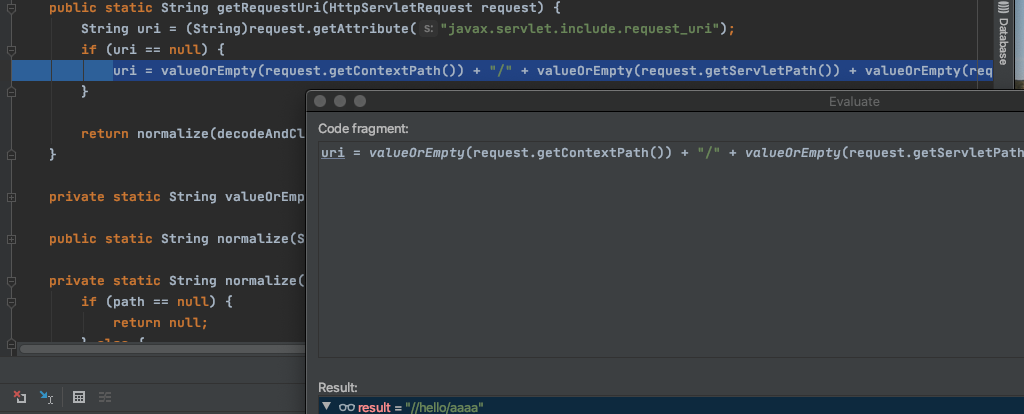
2、CVE-2020-11989
原理
这里的 shiro 拦截器需要变成map.put("/hello/*", "authc");,这里有两种poc,都是可以绕过
/hello/a%25%32%66a
/;/test/hello/aaa
我们知道在shiro中的WebUtils#getPathWithinApplication这里会处理我们传入的url,在 getRequestUri 方法会调用 decodeAndCleanUriString 进行处理。
public static String getRequestUri(HttpServletRequest request) {
String uri = (String) request.getAttribute(INCLUDE_REQUEST_URI_ATTRIBUTE);
if (uri == null) {
uri = valueOrEmpty(request.getContextPath()) + "/" +
valueOrEmpty(request.getServletPath()) +
valueOrEmpty(request.getPathInfo());
}
return normalize(decodeAndCleanUriString(request, uri));
}
在 decodeAndCleanUriString 当中会调用 decodeRequestString 针对 URI 进行一次 URL 解码。
private static String decodeAndCleanUriString(HttpServletRequest request, String uri) {
uri = decodeRequestString(request, uri);
int semicolonIndex = uri.indexOf(';');
return (semicolonIndex != -1 ? uri.substring(0, semicolonIndex) : uri);
}
public static String decodeRequestString(HttpServletRequest request, String source) {
String enc = determineEncoding(request);
try {
return URLDecoder.decode(source, enc);
} catch (UnsupportedEncodingException ex) {
if (log.isWarnEnabled()) {
...
}
return URLDecoder.decode(source);
}
}
所以这里的poc/hello/a%25%32%66a------>传入到shiro自动解码一次变成//hello/a%2fa------>经过 decodeRequestString 变成//hello/a/a
由于这里我们的拦截器是map.put("/hello/*", "authc");,这里需要了解一下shiro的URL是ant格式,路径是支持通配符表示的
?:匹配一个字符
*:匹配零个或多个字符串
**:匹配路径中的零个或多个路径
/*只能命中/hello/aaa这种格式,无法命中/hello/a/a,所以经过 shiro 进行权限判断的时候自然无法命中。

而在spring当中,理解的 servletPath 是/hello/a%2fa,所以自然命中@GetMapping("/hello/{name}")这个mapping,又springboot转发到响应的路由当中。

另一种利用方式来自这里《Apache Shiro权限绕过漏洞分析(CVE-2020-11989)》,这里提到了
- 应用不能部署在根目录,也就是需要context-path,server.servlet.context-path=/test,如果为根目录则context-path为空,就会被CVE-2020-1957的patch将URL格式化,值得注意的是若Shiro版本小于1.5.2的话那么该条件就不需要。

这里原因在于需要绕过 getRequestUri 当中的格式化uri,当 context-path 为空的时候,处理结果为//hello/aaaa
public static String getRequestUri(HttpServletRequest request) {
String uri = (String) request.getAttribute(INCLUDE_REQUEST_URI_ATTRIBUTE);
if (uri == null) {
uri = valueOrEmpty(request.getContextPath()) + "/" +
valueOrEmpty(request.getServletPath()) +
valueOrEmpty(request.getPathInfo());
}
return normalize(decodeAndCleanUriString(request, uri));
}

当 context-path 不为空的时候,处理结果为/;/test/hello/aaaa,然后我们知道 decodeAndCleanUriString 会根据;进行截断,截断之后的结果是/自然无法命中拦截器map.put("/hello/*", "authc");,所以自然就绕过了。


修复
在1.5.3版本,采用标准的 getServletPath 和 getPathInfo 进行uri处理,同时取消了url解码。
public static String getPathWithinApplication(HttpServletRequest request) {
return normalize(removeSemicolon(getServletPath(request) + getPathInfo(request)));
}
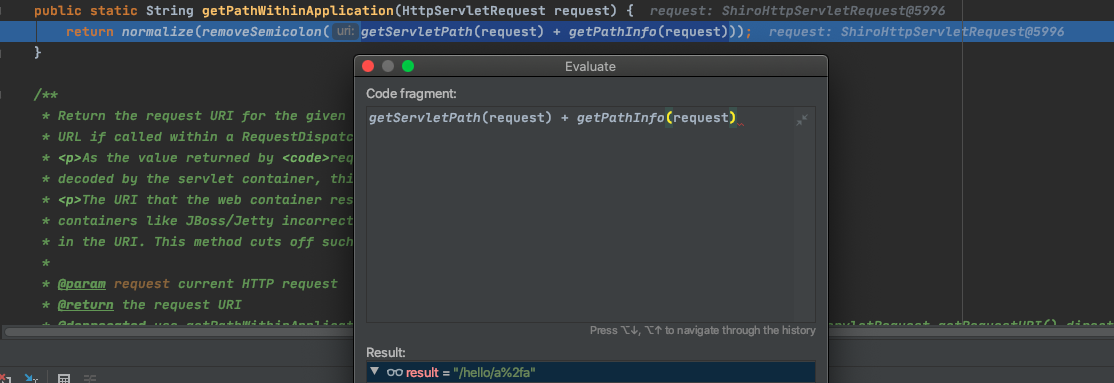
3、CVE-2020-13933
原理
/hello/%3baaaa
上面的代码进来之后,通过 getPathWithinApplication 处理之后变成了/hello/;aaaa

而 removeSemicolon 会根据;进行截断,返回的 uri 自然是/hello/
private static String removeSemicolon(String uri) {
int semicolonIndex = uri.indexOf(';');
return (semicolonIndex != -1 ? uri.substring(0, semicolonIndex) : uri);
}
这个 uri 自然无法命中拦截器map.put("/hello/*", "authc");自然就过了

修复
加了一个 filter 类 InvalidRequestFilter 来针对一些东西进行处理。
private static final List<String> SEMICOLON = Collections.unmodifiableList(Arrays.asList(";", "%3b", "%3B"));
private static final List<String> BACKSLASH = Collections.unmodifiableList(Arrays.asList("\\", "%5c", "%5C"));

0x03 小结
总结来看,就是利用 shiro 解析 uri 和 spring 解析 uri 之间的差异来挖这个洞。
- 本文作者: l1nk3r
- 本文来源: 奇安信攻防社区
- 原文链接: https://forum.butian.net/share/96
- 版权声明: 除特别声明外,本文各项权利归原文作者和发表平台所有。转载请注明出处!


